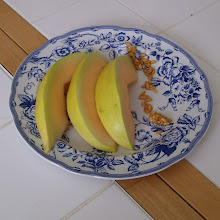Tuesday, October 27, 2009
Bourrée
Why must the first few measures of pieces be so difficult? This is the case both with my Kreutzer étude and my Bach movement for this week. The first four measures of the first section are full of chords. When playing them, I think of Irene Rissi (sp?) telling me to smile with my bow. Smiling with the bow means you start at the frog, move your hand down as you hit the chord, then lift your hand up again as you lift the bow off the strings and bring it back to the frog. It makes for a nice clean release from the string so that the chord rings well.
After those first few measures, the rest of the section isn't very hard. The chords come naturally.
The second section is more difficult than the first. It's also much longer.
At about 1:50 into the recording, there is a section that isn't predicted by anything earlier in the movement. Ouf of the blue come these eighth-note melodies and chords broken into single notes (1:50). Then, from 1:59 to 2:06, there's a new melody with a great rhythm. Bach eventually brings the music back to the opening chords to finish the movement. The end of this movement almost seems like a cadenza that ends when the orchestra comes back in playing a familiar theme. Like a cadenza, this section feels improvisatory.
Bach is often surprising. I'm sure I mentioned earlier how disappointed I was when I learned that there were some rules composers followed when writing music; therefore, it wasn't as magical as I had once thought. Bach still has his fair share of magic. What rule could tell you to throw a major section into the Ciaccona where he did, for example? It's like the sun coming out.
I hate to say it, but I think that changing from minor to major like that always sounds like the sun coming out. A composer could just say, "Ok, time for a little sun," and the magic would be gone. Tchaikovsky does the same thing in his violin concerto at the end of the stormy first movement cadenza where a trill changes from minor to major and then the flute comes in playing a happy theme to accompany the formerly lonely violin.
Kreutzer No. 11
Subscribe to:
Post Comments (Atom)

No comments:
Post a Comment